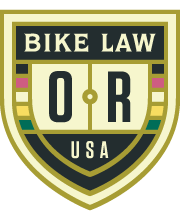Sep 05, 2014
Oregon Bicycle Accident Attorney Bob Mionske on “Safe Passing” laws and the three-foot rule
A cyclist was seriously injured in an Oregon bicycle accident on Wednesday morning. The cyclist, Richard Barrett, 67, of Corvallis, Oregon was riding his bicycle on the shoulder of NW Hill Road in McMinnville, Oregon at 9:30 A.M. when a tractor-trailer towing heavy duty farm machinery began to pass. Although the truck itself did not collide with Barrett, police believe that the farm machinery that was being towed struck Barrett, inflicting serious injuries.
Barrett received emergency treatment by first responders on the scene, before being taken to Willamette Valley Medical Center. From there, the injured cyclist was transported by Life Flight helicopter to Oregon Health & Science University in Portland, Oregon.
No citations were issued at the scene of the crash, but the investigation into the collision is continuing.
In Oregon, drivers are required by law to pass cyclists at a safe distance. However, Oregon’s safe-passing law is unique and distinct from the safe-passing laws of all other states. To understand what makes the law in Oregon unique, it helps to first establish what other states require.
All states require drivers to pass at a “safe distance.” However, Some states (currently 23 states) have gone a step further and require drivers to leave a “minimum safe passing distance” when passing a cyclist. This “minimum safe passing distance” is typically specified as 3 feet (although Pennsylvania requires 4 feet, and New Hampshire’s law — the best in the nation — has a minimum safe passing distance that increases as the driver’s traveling speed increases); because the minimum safe passing distance is typically specified as 3 feet, these laws are often called “3 foot laws.” The states that have not specified a minimum safe passing distance still require that drivers make passes at a safe distance, but do not specify what the minimum safe passing distance is.
By “minimum safe passing distance,” the states mean that drivers must leave at least the minimum distance specified by law between their vehicle and the cyclist they are passing. However, drivers are required to leave more than the minimum distance when passing a cyclist if more distance is necessary for the cyclist’s safety. By specifying a “minimum safe passing distance,” the states have instructed drivers that lesser passing distances are not safe, and drivers who hit cyclists because they passed at an unsafe distance can no longer argue that they were passing at a safe distance but hit the cyclist because the cyclist made a mistake.
Now let’s take a look at how Oregon’s safe passing law is different. In Oregon, drivers are required to pass cyclists at a safe distance, as in every other state. However, unlike other states, this “safe distance” is specified as “a distance that is sufficient to prevent contact with the person operating the bicycle if the person were to fall into the drivers lane of traffic.” There are exceptions to this safe passing distance, however. Drivers are not required to observe this safe passing distance when they are operating “in a lane that is separate from and adjacent to a designated bicycle lane,” or driving “at a speed not greater than 35 miles per hour,” or “when the driver is passing a person operating a bicycle on the persons right side and the person operating the bicycle is turning left.”
Unfortunately, these exceptions mean that Oregon’s law is seriously flawed. Although Oregon’s approach to specifying a “minimum safe passing distance” encourages drivers to make passes greater than 3 feet, the exceptions to Oregon’s “minimum safe distance” passing law unnecessarily endanger cyclists by erroneously encouraging drivers to make unsafe passes in these specified situations. The reason this law “erroneously encourages” drivers to make unsafe passes is becauseOregon law still requires drivers to make safe passes at all times, regardless of the exceptions to the minimum safe passing distance law.
Returning to the scene of Wednesday morning’s bicycle accident in McMinnville, it is unclear at this time what speed the driver, identified as Kasey Kauer, 33, of Amity, Oregon, was traveling at when he attempted to pass the cyclist. Nevertheless, the fact that his trailer or its projecting load struck the cyclist indicates that the driver violated Oregon’s basic safe passing law. A driver cannot construe an unsafe pass as being “legal” if the trailer or projecting load, rather than the vehicle itself, is what strikes somebody. Furthermore, every driver has a basic duty under Oregon law to exercise reasonable care while operating a vehicle.
In addition to these basic requirements that apply to every driver, this driver was operating a tractor-trailer that was towing heavy-duty machinery projecting beyond the width of the tractor-trailer. In Oregon, this driver is likely subject to additional responsibilities, including special licensing requirements, special insurance requirements, and special permit requirements. Because the driver is granted special permission by the state to operate dangerous machinery, the driver has a corresponding duty to exercise due care consistent with that special permission, and the state specifies that among other things, the driver and the permittee are “responsible and liable for any and all injury to persons and damage to property.” Because it appears likely that this driver did not observe his legal duties required by the state, he will likely be found at fault in this bicycle accident.
In addition to violating the law by making an unsafe pass, the driver is also in violation of Oregon’s Vulnerable User law, which imposes enhanced penalties on careless drivers who seriously injure or kill cyclists and other vulnerable users. These enhanced penalties include a maximum fine of $12,500, a one-year suspension of driving privileges, completion of a traffic safety course, and 100 to 200 hours of community service. If a driver completes the traffic safety course and community service within one year, the court shall not order the enhanced fine and license suspension. In a nutshell, this means that if the driver completes a traffic safety course and 100 to 200 hours of community service related to traffic safety, he will not be ordered to pay the enhanced fine or have his license suspended for a year.
The goal of the Vulnerable User law is clearly oriented towards improving traffic safety, rather than towards punishment of careless drivers. Unfortunately, while the enhanced penalties send a message to drivers that they must be careful while driving, the relatively easy ability to avoid the enhanced penalties sends a different and contradictory message to drivers.
Depending upon the results of the accident investigation, the driver may be found to have committed other violations of the law as well. Ultimately, however, unless the driver is found to have committed a serious traffic crime, it is unlikely that the traffic violations committed by this driver will result in serious penalties imposed against the driver.
And while imposing penalties for careless driving is essential, not just for justice, but for the message to the driving public that imposing penalties (or failing to impose penalties) sends, justice for this injured cyclist will ultimately mean some combination of penalties against the driver responsible for injuring him, and financial compensation for the injuries he has suffered.
***
This article, Unsafe Pass Seriously Injures Oregon Cyclist, was originally published on Bike Law on September 5, 2014.






